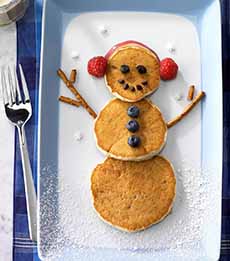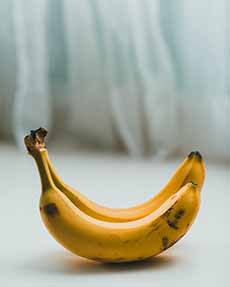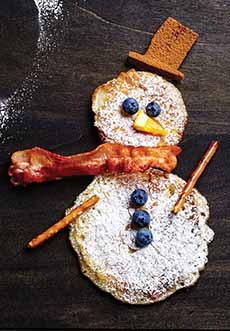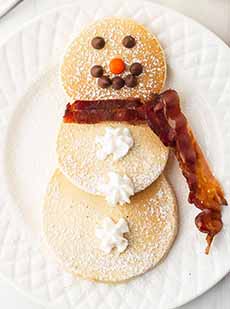Banana Snowman Pancakes Recipe For Cold Winter Mornings
|
|
If you’re in a neck of the woods that’s brrr-cold, here’s a cheerful breakfast that will ease the pain of leaving the house. It’s such fun food that it just might be in demand for lunch and dinner, too. And with fruit purée instead of maple syrup, it works for dessert. The recipe below is for banana pancakes (mashed bananas in the batter). But if you’d prefer a plain pancake, check out these snowman pancakes. > The history of snowmen is below. > Our favorite artisan pancake mix brands. Thanks to Phyllis Schmalz of Kansas City, Kansas, and Taste Of Home for bringing us this recipe. Total time to prepare and cook is 20 minutes. 2. POUR a scant 1/2 cup batter onto a greased hot griddle, making 3 circles to form a snowman. Turn when bubbles form on top and cook until the second side is golden brown. 3. TRANSFER to a serving plate. Repeat with the remaining batter. 4. SPRINKLE the plates with confectioners’ sugar (snow). It’s easy to do by shaking it in a sieve. Add the snowmen and decorate with pretzels arms chocolate chips, cranberries. Use a bit of orange segment for the nose. Use pretzel sticks for the arms. Cut a slice of apple or banana for hats. On a separate plate, dust the hats with cocoa powder and then carefully transfer to the heads of the snowmen. 5. SERVE with extra banana slices to increase the fruit intake. And while the confectioners’ sugar “snow” provides sweetness, you can serve maple syrup if desired. According to our colleague Claude.ai, the history of building snowmen is centuries old. The Middle Ages: The earliest documented snowman was found in an illuminated manuscript Book of Hours, from from 1380. This confirms that the practice was already well-established at the tail end of medieval Europe (also known as the Middle Ages, ca. 5th century to the late 15th century). During this period, snowmen were often seen as public art forms, with entire cities participating in creating elaborate snow sculptures during particularly harsh winters. By the Victorian era (1837-1901), building snowmen had become associated with childhood recreation and family activities. While medieval snowmen were often decorated with twigs and leaves, the iconic design we know today—three stacked snowballs with coal eyes and a carrot nose—became standard during this period. Modern Times: Another landmark for snowmen was 1950, when the song “Frosty the Snowman” was released. It was first recorded by Gene Autry, and later recorded by Jimmy Durante and Nat King Cole the same year. Many covers followed. We’re partial to the versions from Bing Crosby and The Chipmunks (much more fun, we think, than the Jackson 5). Children’s books, cartoons, and films followed. We have not checked to see if Frosty has social media accounts. |
|
|
________________ The late Middle Ages saw a gradual shift towards the intellectual and artistic ideas that would later define the Renaissance. The early stages of the Renaissance, often called the Proto-Renaissance, are considered to have occurred during the late Middle Ages, particularly in Italy. Historians concur that the Renaissance ended in the early 17th century. The Age of Enlightenment emerged from the intellectual and scientific advancements sparked during the Renaissance period. It was characterized by a strong emphasis on reason, logic, and scientific inquiry, with philosophers like Locke, Montesquieu, and Voltaire contributing significantly to its ideas. Romanticism emerged in the late 18th and early 19th centuries, characterized by a focus on emotion and imagination: an interest in nature, the supernatural, personal experiences, and artistic freedom. Many historians view the turbulent events of the French Revolution as a turning point marking the end of the Enlightenment and the rise of Romanticism, which gradually gave way to… Realism, which emphasized depicting the world as it actually is, with a focus on everyday life and social issues. CHECK OUT WHAT’S HAPPENING ON OUR HOME PAGE, THENIBBLE.COM.
|
||







